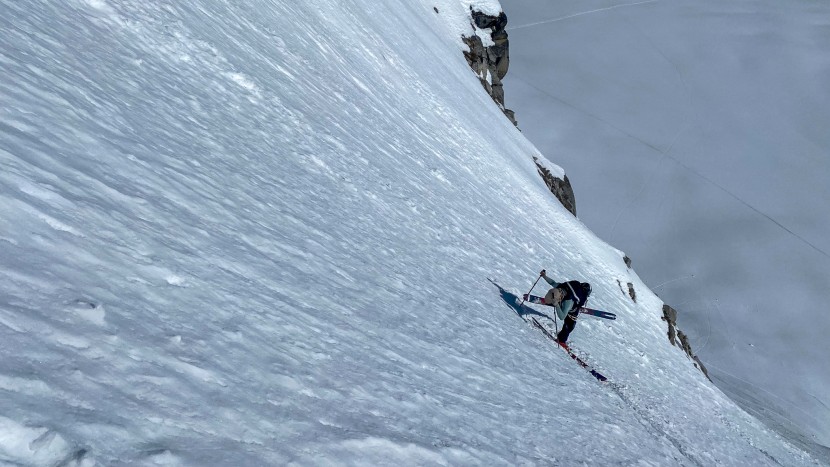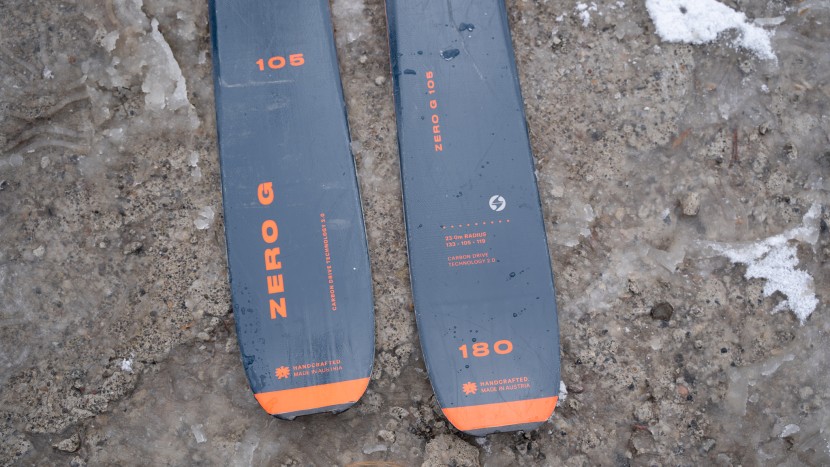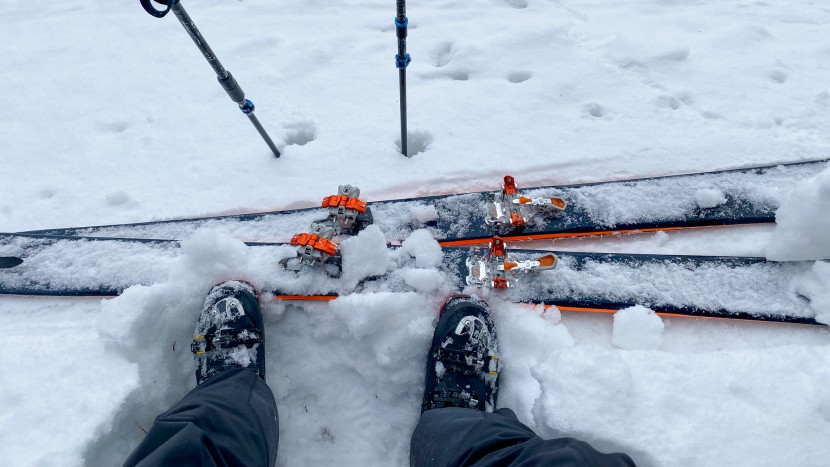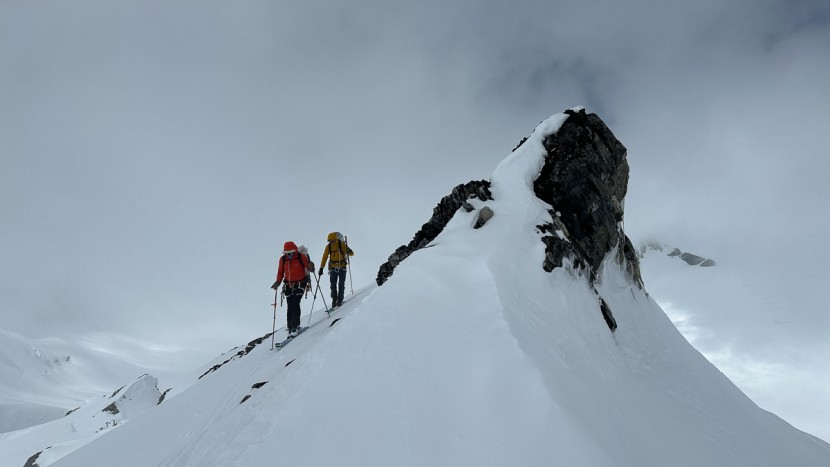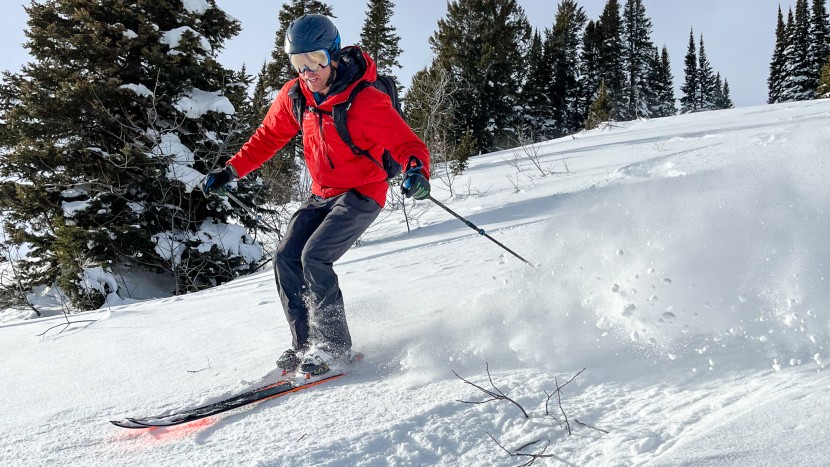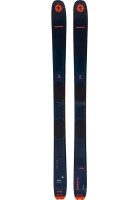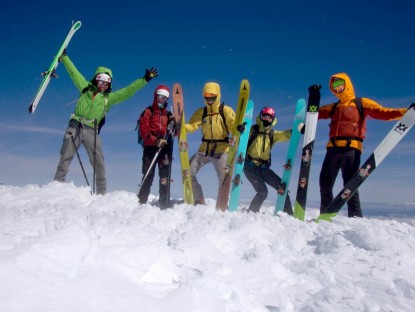Blizzard Zero G 105 Review

Our Verdict
Our Analysis and Test Results
The Blizzard Zero G 105 is incredibly versatile. It performs well in steep, slow, firm couloirs and blasts through low-angle, deep powder skiing. It doesn't punish intermediate skiers and has enough depth to satisfy expert backcountry chargers. The touring weight, given the high level, diverse downhill performance, is remarkable.
Weight
We look very closely at lots of precise and nuanced details when we assess ski gear for these reviews. Sometimes, when we let ourselves step back from the nitty gritty, we see a “big picture” matter that really jumps out at us. There are lots of good reasons to pull out the microscope. There are just as many reasons to step back across the room and look at our charts through metaphorically squinted eyes. When we sort a list of all our tested skis by weight, the Blizzard Zero G 105 stands out. Everything that is lighter skis much more delicately. In the other direction, we have to add hundreds of grams per ski before we get to something we would rate over this Blizzard in all-around downhill scores. To be honest, this is how we really “sealed the deal” on granting the Zero G 105 the top award. Skiing it, day to day, through a varied season and paired with relatively heavy bindings, most of our test team didn't fully appreciate just how light it was. It skis like a heavier ski. So much so that it wasn't until we sat around and looked at the full list of recent skis and weights that it all clicked into place.
On our calibrated scale, the test pair of Blizzard Zero G 105 in 180cm length weigh 3025 grams. That's 6.7 pounds for the pair and 1513 grams per ski (specifically, 1515 grams for one ski and 1510 grams for the other). We've long granted two Editors Choice winners in this category. Both have to be suitable for a “quiver of one” application. One leans light and the other leans heavy. The light winners in recent years have been between 1200 and 1300 grams. In that weight range, the winners have been decisive. Two products, in sequence, shared that award for 5 years (and running) now. Each year the winner in that “lightweight all around” sub-sub-category has been clear from the beginning. The other sub-sub-category ("Best Mid-to-Heavy All-Around Ski for Human Powered Skiing" — a mouthful, and maybe splitting hairs, but that's just how we do it) has been muddier. We've jumped the award around, never really decisive or content — until now. The Zero G 105, at just over 1500 grams, is a better choice for more skiers than anything in the weight vicinity. It is hard to imagine something easily displacing this ski from its award slot.
Firm Snow
We would ski the iciest snow with the Blizzard Zero G 105. In fact, we did exactly that. The Mountain West's recent winter drought forced us to test in uncharacteristically firm February snow conditions. Especially at home in the Tetons, in February, we don't expect to be skiing the backcountry and not leaving tracks. But we did exactly that. And had a great time doing so. That said, firm snow is the only “weakness” of the Zero G (on the other hand, a narrower version of the Zero G is still the best ski we have used for skiing ice). When we juggle around lists of the individual scoring matrices we use for assessing performance in each of three types of snow (firm, powder, poor snow), something stands out. Only two beat the Zero G in tough snow, and both are much heavier. Only three beat the Zero G in powder, and all three are essentially useless in one or more other conditions. On firm snow, though, we list a handful of products that beat the Zero G 105.
As noted, when pressed to own a weakness of the Zero G 105, it has to be icy snow. If your habits and travels include more than 10 to 15% firm snow skiing, look elsewhere for your all-around backcountry skis, or complement the Zero G with something firm snow specialized. Otherwise, be psyched with the acceptable icy snow performance of the Zero G and know that you've got above-standard performance everywhere else.
Powder
What doesn't ski powder well, really? Lots of skis are fun in powder snow; the snow does the work. That said, the best all-around skis enhance your powder ski experience, and the Zero G 105 is among the best all-around touring skis available. We like their float, their snappy pop, their ability to carve and lengthen the turns. When you need to slow it down and turn more, the Zero G is right there with you.
We didn't ski a ton of super deep powder on the Zero G 105. This round, our notes indicate that about 20% of our testing with this ski was in true powder snow. That's a relatively low percentage for our discerning, intermountain test team. We had favorable experiences, but we look forward to bolstering our review confidence with more “data collection” in upcoming seasons. It is hard to imagine tempering our enthusiasm for this ski's performance, but we have to own where our data is limited and where we still need to collect information.
Crud/Poor Snow
As noted above, very few skis in our test exceed the poor snow experience of riding the Blizzard Zero G 105. For the weight, nothing we've ridden is better. This Blizzard tracks straight, planes out consistently and evenly, and resists tip-crossing and catching better than most. At some point, all skiers will have to revert to survival turns in degrading snow conditions. On the Zero G, that “survival ski threshold” is further along than with many other skis, especially in this weight range.
You are going to find poor snow at least some of the time. The backcountry isn't what you usually see in movies and on Instagram. Along the continuum from great snow to the worst, your technique and ski equipment will work together to keep you making “normal” ski turns. Eventually, along the whole spectrum of poor snow, everyone on every ski will need to resort to survival turns. If an average skier on average backcountry touring skis in this weight range would get 50% of the way across the continuum with their parallel turns, that same skier would get 60-65% of the way across with the Blizzard. The absolute best poor-snow skis (theoretical skis that, for one thing, would weigh a lot more than the Zero G) would get that same skier about 75% across the spectrum. Overall, the Blizzard Zero G 105 does quite well in all the different types of poor snow conditions.
Stability at Speed
Here we look at stability in two major settings. First, as directly stated, at high speed in mellow terrain. And, related, at slower, more methodical speeds in super steep terrain, as in “jump turns”. The attributes that inform performance in both of these situations are the same. Skis need to track reliably and together. They need to absorb forces without “folding” or giving in to said forces, an attribute often described as “dampness”. In all the ways, the Blizzard Zero G 105 is quite stable. We could certainly ski way faster than is responsible in the backcountry. Further, in way steep terrain, we could stomp to quick and quiet stops after every techy turn.
We mention skiing “faster than is responsible”. Most of us do, most of the time. It is why we ski in the first place. If we were fully cognizant and respectful of the consequences of crashing in the wild at high speed, we'd probably not go backcountry skiing at all. We are going to take on some risks; going to the backcountry is inherently dangerous. When the speeds ramp up, you want your skis to track straight and absorb irregularities in snow, terrain, and your technique. This Blizzard award winner does all that way better than most.
Should You Buy the Blizzard Zero G 105?
We are big fans of this ski. It isn't flashy or trendy, either in performance, graphics, or branding/marketing. But it is rock solid on snow of all types across a huge range of terrain, for skiers of many types. If you seek a “quiver of one” backcountry touring/ski mountaineering ski and your preferences lean slightly to the downhill, this is the best around, especially if your patterns involve more soft snow than firm snow. That sounds like a lot of qualifiers, but it also describes the vast majority of modern backcountry skiers.
What Other Backcountry Skis Should You Consider?
If you like what we have to say about the Blizzard Zero G 105 but can't find them when you need them, the K2 Wayback 106 fills the same niche with just a touch less overall ski performance. If you don't mind trading off a little additional weight for slight improvements in downhill skiing, the similarly sized Salomon QST Echo 106. However, if you would like to go skinnier, the Atomic Backland 95 is our choice for steep, firm skiing.
| Awards | Best Overall Backcountry Skis |
|---|---|
| Price | $950 List Check Price at Backcountry |
Overall Score  |
|
| Star Rating | |
| Bottom Line | This is our favorite ski for modern, all-around backcountry skiing, with traditional reliability, modern dimensions, and well-balanced performance |
| Pros | Stable, versatile, good flotation, well-balanced |
| Cons | Moderately heavy, not optimal for skiing firm snow |
| Rating Categories | Blizzard Zero G 105 |
| Weight (25%) | |
| Firm Snow (20%) | |
| Powder (20%) | |
| Crud and Poor Snow (20%) | |
| Stability at Speed (15%) | |
| Specifications | Blizzard Zero G 105 |
| Measured Weight Per Ski (g) | 1513 |
| Measured Length Tested (cm) | 178 |
| Measured Waist Width (mm) | 105 |
| Weight Per Surface Area Ratio (g/cm²) | 0.72 |
| Measured Weight Per Pair (g) | 3025 |
| Measured Weight Per Pair (lbs) | 6.7 |
| Manufacturer Claimed Length (cm) | 180 |
| Available Lengths (cm) | 164, 172, 180, 188 |
| Measured Dimensions, Tip/Center/Tail (mm) | 133/104/118 |
| Manufacturer Claimed Dimensions (mm) | 133/105/119 |
| Turn Radius (m) | 23 |
| Construction Type | Sandwich |
| Core Material | Paulownia |
| Rocker/Camber Profile | Tip and tail rocker |




